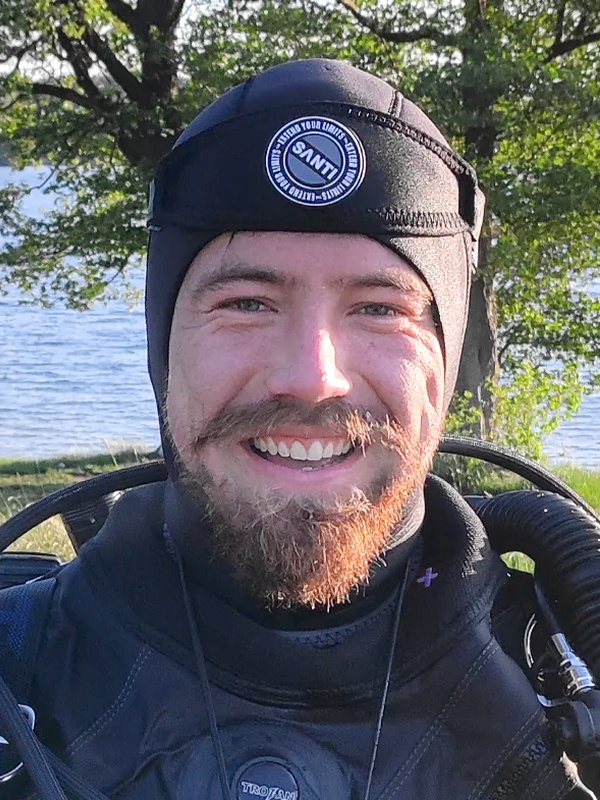|
Research interests
Peruvian marine biologist, scientific diver, and underwater cameraman currently working with Arctic Antarctic, and Southeastern Pacific macrobenthic assemblages. I am focused on benthic ecology particularly in ecosystems highly vulnerable to climate change such as polar benthos, islands, and high-altitude lakes. Interested in the utilisation of underwater imagery to gather valuable information in sublittoral ecosystems by means of the least invasive approach.
Education
-
2021 – present: PhD student. Subject: Marine polar benthic ecology – “Marine biocoenosis succession on hard substrata in the rapidly changing environment of Arctic coastal shallows” (Supervisors: Prof. Piotr Kukliński, Dr. David K.A. Barnes, Prof. Lee Hsiang Liow)
-
2019-2020: MSc. Climate Change: Managing the Marine Environment; Heriot-Watt University, Scotland, UK. Thesis: “The multidimensional nature of growth in cheilostomatous bryozoans: Where to look in changing oceans” (Supervisor: Dr. Joanne S. Porter)
-
2009-2013: BSc. Marine Biology; Universidad Científica del Sur, Lima, Peru. Undergraduate thesis: “Classification and spatial distribution of the macrozoobenthos at the Mackellar inlet, King George Island, Antarctica: contrasting two approaches of ecological analysis” (Supervisor: Dr. Cesar O. Pacherres)
Publications
-
Szeligowska M, Moreno B (Preprint) Polar biocenosis cumulative response to environmental stressors reveals who benefits from marine ice loss. Authorea, https://doi.org/10.22541/au.166939382.20700189/v1
-
Moreno B, Szeligowska M (Accepted). Browning and blueing–what is the fate in polar regions? Frontiers in Ecology and the Environment–Frontiers EcoPics.
-
Sands CJ, Zwerschke N, Bax N, Barnes DKA, Moreau C, Downey R, Moreno B, Held C, Paulsen M (2023) The growing potential of Antarctic blue carbon. Oceanography, 36 (Supplement 1);
https://doi.org/10.5670/oceanog.2023.s1.5
-
Thorne DCS, Moreno B, Indacochea AG (2022). Growth form classification for sessile suspension feeders and their distribution in Antarctic fjord, King George Island. Polish Polar Research, 43(3): 267-289; https://doi.org/10.24425/ppr.2022.140364
-
Polo C, Moreno B, Arroyo Y, Cóndor-Luján B (2022) On some cryptic sponges associated with Lessonia trabeculata holdfasts in the South-eastern Pacific. Marine Biology Research; https://doi.org/10.1080/17451000.2022.2123521
-
Moreno B (2022) Our prevailing fossil dependency and the need for nature-based solutions: remarks on recent South Sustainability publications. South Sustainability, 3(2); https://revistas.cientifica.edu.pe/index.php/southsustainability/article/view/1211/976
-
Moreno B, Cevallos B, Gómez Sánchez R, Torrejón-Zegarra R, Aller-Rojas O (2021) A detailed underwater and on-board workflow for marine ecological research, using a subtidal kelp forest study. South Sustainability, 2(2): https://doi.org/10.21142/SS-0202-2021-m001
-
Moreno B (2020) Keeping track of scientific dives in countries with incipient diving programmes: the SciDive record forms. Polish Hyperbaric Research, 3(72): 29-38; https://doi.org/10.2478/phr-2020-0015
-
Barnes DKA, Sands CJ, Paulsen ML, Moreno B, Moreau C, Held C, Downey R, Bax N, Stark J, Zwerschke N. (2021) Societal importance of Antarctic negative feedbacks on climate change; blue carbon gains from sea ice, ice shelf and glacier losses. The Science of Nature, 108(43); https://doi.org/10.1007/s00114-021-01748-8
-
Moreno B (2021) Climate emergency and the acute urgency of revisiting Humboldt’s holistic approach. South Sustainability,1(2): e021; https://revistas.cientifica.edu.pe/index.php/southsustainability/article/view/770/749
-
Bax N, Sands CJ, Gogarty B, Downey RV, Moreau CVE, Moreno B, Held C, Paulsen ML, McGee J, Haward M, Barnes DKA. (2020) Perspective: Increasing Blue Carbon around Antarctica is an ecosystem service of considerable societal and economic value worth protecting. Global Change Biology, 27(1); https://doi.org/10.1111/gcb.15392
-
Aller-Rojas O, Moreno B, Aponte H, Zavala J. (2020) Carbon storage estimation of Lessonia trabeculata kelp beds in Southern Peru: an analysis from the San Juan de Marcona region. Carbon Management, 11(5):1–8; https://doi.org/10.1080/17583004.2020.1808765
-
Moreno B. (2020) A simple in situ labelling approach and adequate tools for photo and video quadrats used in underwater ecological studies. Underwater Technology, 37(1): 29–33. https://doi.org/10.3723/ut.37.029
-
Gogarty B, McGee J, Barnes DKA, Sands CJ, Bax N, Haward M, Downey RV, Moreau CVE, Moreno B, Held C, Paulsen ML. (2020) Protecting Antarctic blue carbon: as marine ice retreats can the law fill the gap? Climate Policy, 20(2):149–162; https://doi.org/10.1080/14693062.2019.1694482
-
Waller CL, Griffiths HJ, Waluda CM, Thorpe SE, Loaiza I, Moreno B, Pacherres CO, Ryan P, Suaria G, Isobe A, Hughes KA. Microplastics in the Southern Ocean. Antarctic Environments Portal.
-
Moreno B, Gonzalez-Pestana A. (2017) Southernmost record of the Giant Manta Ray Mobula birostris (Walbaum, 1792) in the Eastern Pacific. Marine Biodiversity Records, 10:27. https://doi.org/10.1186/s41200-017-0130-1
-
Waller CL, Griffiths HJ, Waluda CM, Thorpe SE, Loaiza I, Moreno B, Pacherres CO, Hughes KA (2017) Microplastics in the Antarctic marine system: An emerging area of research. Science of The Total Environment, 598:220-227. https://doi.org/10.1016/j.scitotenv.2017.03.283
|

